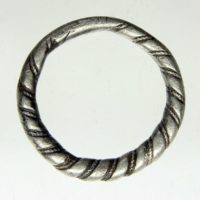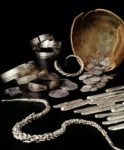 A rare silver Viking ring was acquired by the Rijksmuseum van Oudheden (RMO) in Leiden just before it had to close its doors last month. A metal detectorist found it in a cornfield near Hoogwoud in the province of Noord Holland on Christmas Day 2019. It was bought quickly from the finder for an undisclosed sum and is now part of the national collection.
A rare silver Viking ring was acquired by the Rijksmuseum van Oudheden (RMO) in Leiden just before it had to close its doors last month. A metal detectorist found it in a cornfield near Hoogwoud in the province of Noord Holland on Christmas Day 2019. It was bought quickly from the finder for an undisclosed sum and is now part of the national collection.
With a diameter of 25mm, a tiny hair under an inch, and weighing eight grams, the ring is quite large. It was made by twisting two silver wires, one thicker, one fine filigree thread made with tiny balls, together. The braided style was in use by Viking goldsmiths from the 9th through the 11th century A.D. This ring dates to the 10th century.
Danish Viking began raiding The Netherlands in the 9th century, occupying the Dutch coast briefly but they didn’t settle permanently as they did in Ireland or York. They established temporary quarters where they camped out in the winter between raids and sea journeys in what is today the  province of Noord Holland. A Viking silver hoard from the 9th century discovered in Westerklief, less than 20 miles north of Hoogwoud, is now in the collection RMO. There’s a braided silver bracelet in the hoard made using the same technique as the newly acquired ring.
province of Noord Holland. A Viking silver hoard from the 9th century discovered in Westerklief, less than 20 miles north of Hoogwoud, is now in the collection RMO. There’s a braided silver bracelet in the hoard made using the same technique as the newly acquired ring.
The size of ring could mean it was made for a sausage-fingered Viking, but RMO curator Annemarieke Willemsen believes it was actually worn as a pendant. The twisted strands flatten and thin out at the top where it dangled from a chain or tie. The wasn’t happenstance; the ring appears to have been deliberately designed to be a pendant and the wear pattern confirms that it was hung from the thin part.
It looks like a miniature version of the neck torcs that were worn by Viking elite of the time. They too were often made with twisted wires that are thin on one side and then gradually thicken as the braid is woven. Pendants of miniature objects — chairs, axes, swords — were popular in the Viking era.
Objects from the 10th and 11th centuries are rare in the Netherlands. The acquisition of this piece will add significantly to the national collection. The museum is planning to display the ring in a future exhibition.
Einhard (c. 775 – 840) in his ‘Vita Caroli Magni’, ch. 14, lets us know:
——
“After the Saxon war […] The last war of all that Carl undertook was against those Northmen, who are called Danes, who first came as pirates, and then ravaged the coasts of Gaul and Germany with a greater naval force. Their King, Godofrid, was puffed up with the vain confidence that he would make himself master of all Germany. He looked upon Frisia and Saxony as his own provinces. He had already reduced his neighbours the Abodriti to obedience, and had forced them to pay him tribute. Now he boasted that he would soon come to Aachen, the seat of the King’s Court, with a mighty force. His boast, however idle, found some to believe it; it was thought that he would certainly have made such attempt if he had not been prevented by a sudden death. For he was killed by one of his own followers, and so ended both his life and the war that he had begun.”
——
The ‘Annales Regni Francorum’ noticed this in 804, 808, and 809 and claim for 810 that, campaigning against Godofrid, Emperor Carl lost hist valuable war elephant ‘Abul-Abbas’ that he had received from Harun al-Rashid in Bagdad.
BTW, it seems as if, due to some unknown technical reason, we are not supposed to post any –only slightly longer– bits Latin or Greek on here (which may be a little bit of a nuisance to some).